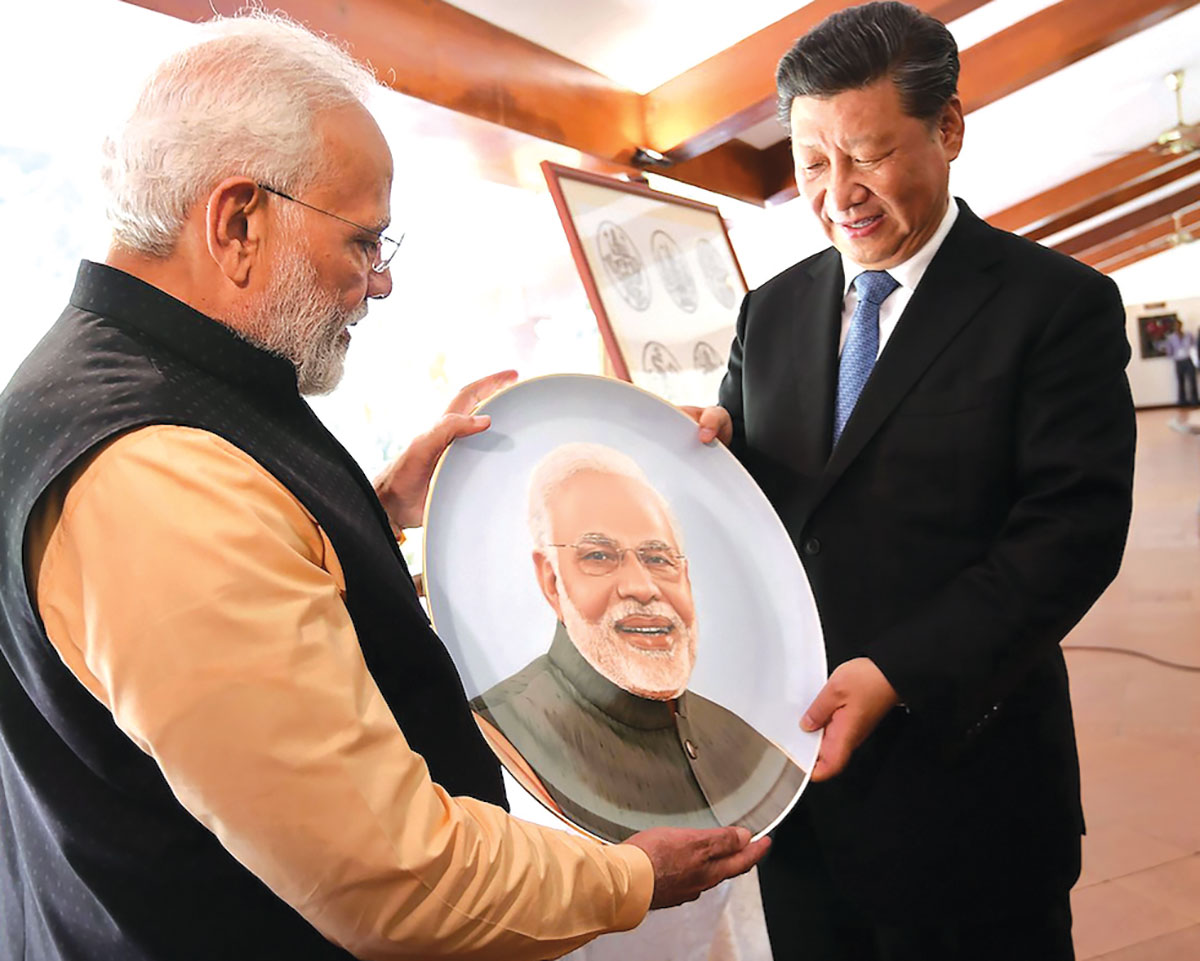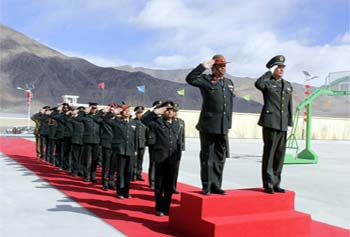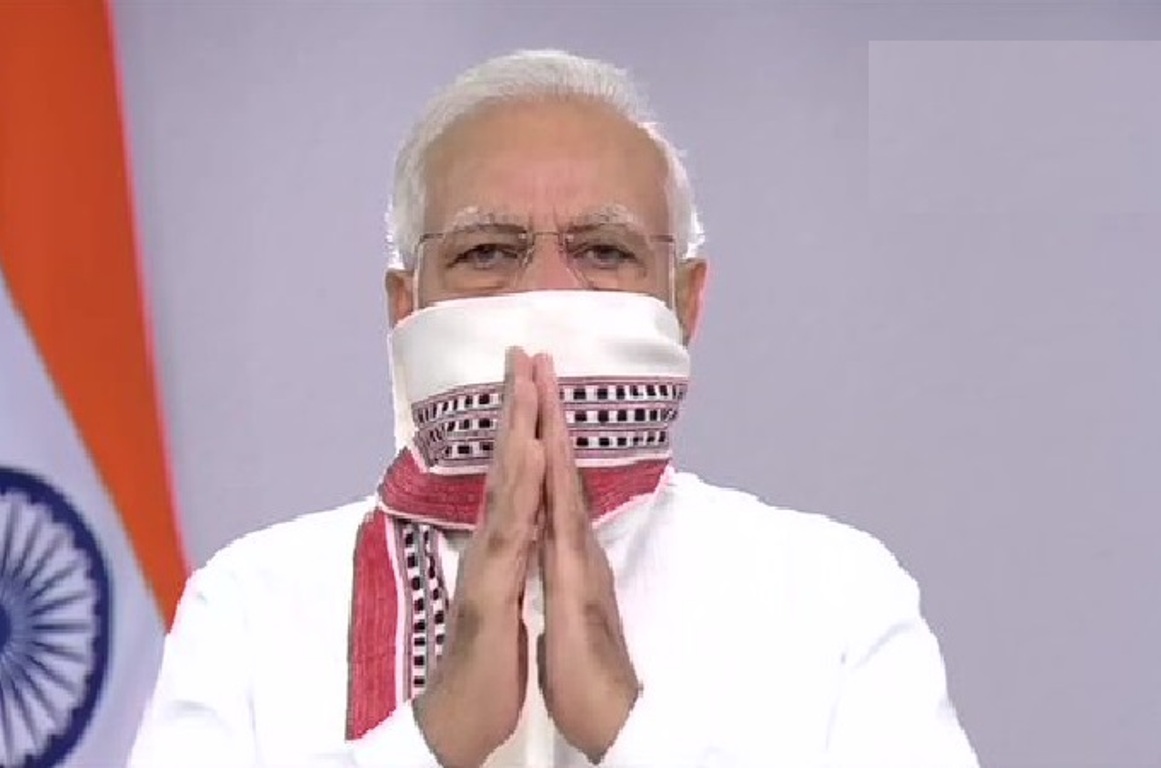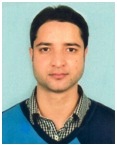SRINAGAR: With the tensions between Delhi and Beijing over the alleged incursions of the Peoples Liberation Army (PLA) in Ladakh going on for almost a month now, a lot of opinions were published by the media within and outside India.
In this column, we are republishing the editorials of the main newspapers published in India.

Chinese premier handing over a handmade portrait to host Prime Minister Narendra Modi in 2019 during his India visit.
Awful Silence: On India-China Standoff
India must publicly clarify the seriousness of the situation with China along the LAC
The Hindu, Chennai
May 30, 2020
Nearly a month after the first skirmishes on the LAC between Indian and Chinese soldiers were reported, the situation on the ground still appears to be tense. While there has been no official explanation of what has happened there since May 5, the day the first clash at Pangong Tso (lake) was reported, there is enough information to conclude that this is the most serious such standoff India and China have seen in years. As reported by The Hindu, sources say that the number of Chinese soldiers, the aggression with which they have dealt with Indian soldiers, as well as the number of points of conflict, indicate strategised action by Chinese commanders.
While both governments have been careful to keep the tone of their comments sober, the fact that both sides have repeatedly mentioned that talks are on is also proof of an ongoing situation. A full de-escalation will entail soldiers being able to return to their normal LAC patrols, something military officers say will probably need a high-level political intervention and for the Indian side, an insistence that Chinese soldiers, who appear to have been the aggressors, returning to positions they previously held.
In the midst of these sensitive negotiations, the interventions by the U.S. come as inopportune distractions. The first comment, last week, by a then senior State Department official, accusing China of being an aggressor on several fronts and posing a “threat” to its neighbours, was followed by President Donald Trump’s offer, this week, to mediate between Delhi and Beijing. Neither comment appears to have been made in consultation with India. India has made it clear that it will not accept Mr Trump’s offer and has denied his claim that he spoke to Prime Minister Modi on the issue. The government’s first priority now must be to end the current standoff, and then for its senior officials to enter serious talks on LAC demarcation.
Given all the new infrastructure being built by India, it may also be necessary to negotiate new border management protocols that were last updated in 2013. The government must also investigate how a big build-up of Chinese soldiers was not acted upon earlier. Beyond this, it must make a full assessment of just what China’s final aims are: is the summer conflagration meant to deflect attention from Beijing’s current problems over the Coronavirus pandemic, to deter India from its infrastructural push for roads and bridges to connect its northern frontiers all the way to the Karakoram pass, or to “remind” New Delhi of its geographical vulnerabilities as it contemplates a closer maritime relationship in the Indo-Pacific with the U.S.? In all three scenarios, the first steps for the government would be to publicly clarify the seriousness of the situation at the LAC, and to build consensus around its plans for a firm pushback and an assertion of its position along the disputed line.
Standing Its Ground
Even as it repels Beijing’s incursions in Ladakh, Delhi must guard against being overtaken in the war of narratives.
The Indian Express, Delhi
May 29, 2020 12:13:35 am
The interesting thing about US President Donald Trump’s offer of mediation between Delhi and Beijing is that it was made at all. It is less about Trump knocking together the heads of Prime Minister Narendra Modi and President Xi Jinping than about signalling American concerns about Sino-Indian military tensions that have become frequent and intense. It comes amid the expanding arc of conflict between the US and China — from trade disputes to Coronavirus and from Huawei to Hong Kong. Despite the massive and unprecedented polarisation in the US, the US political class has come together to project the China threat and agree on the need for a vigorous push-back. Trump’s statement merely extends the argument articulated a few days ago by Alice Wells, a senior official in the State Department. Wells was locating Chinese muscle-flexing on the disputed border in the trend of Beijing’s aggression in many areas, including in the South China Sea.

US President Donald Trump, First Lady Melania Trump and Prime Minister Narendra Modi arrive to attend ‘Namaste Trump’ rally at Sardar Patel Stadium in Motera, on the outskirts of Ahmedabad, on February 24, 2020. Pic: Internet
Trump’s offer is bound to irritate China. Beijing sees itself as Washington’s equal but has convinced itself that China is poised to overtake the US as the predominant power in the Asian theatre. It is especially galling for Beijing, since, not so long ago, China was offering to work with the US to manage the conflicts between Delhi and Islamabad. India and China might have been equals way back in the 1990s; Beijing no longer sees Delhi in the same weight class. Clubbing China with India will be seen as a big put-down in Beijing; and that, probably, was Trump’s intent.
There was a time when Delhi used to jump at any one talking about “mediation”, especially on Kashmir. But now it has learnt the art of fending off these busy-bodies with a smile. And then, Delhi discovered that it could, in fact, leverage international interest in its relations with Islamabad to India’s advantage. In the last few years, it managed to redirect the international concerns on Kashmir towards the sources of cross-border terrorism in Pakistan. In fact, Delhi is actively “internationalising” the question of Pakistan’s sanctuary and support to those fomenting violent extremism in Kashmir. Similarly, Delhi can use the global concerns on a Sino-Indian conflict to counter the PLA’s forward policy. In the name of handling the boundary dispute with Beijing in a purely bilateral framework, Delhi has turned its China strategy into an opaque process that neither the domestic or international public opinion understands. This is a good moment for India to publicise its case for a reasonable boundary settlement with China and contrast it with Beijing’s insatiable territorial greed. If winning the war of narratives is important in today’s world, standing one’s ground in a military standoff is absolutely critical. In a paradox, a Delhi that can repel Beijing’s military incursions on its own will gain ever-larger international political and diplomatic support for India’s contestation with China.
Daring the Dragon
India must tone down the rhetoric, build its capabilities silently
The Tribune, Chandigarh
May 28, 2020
Chinese President Xi Jinping’s call to the People’s Liberation Army on Tuesday to think about worst-case scenarios and to scale up battle preparedness has come at an inopportune moment during a face-off between China and India in Ladakh. Coming as it does from the highest Chinese authority, the message is a riddle, as is often the case with Chinese military-diplomatic signals. It appears more as provocative muscle-flexing rather than a subtle attempt to make its neighbour strike a balance between its priorities, possibilities and vulnerabilities. The Chinese are clearly anxious about a new Cold War in the post-pandemic world and their foreign minister Wang Yi stated it in no uncertain terms, warning the US. In this context, any overture by India towards the US for a quasi-military alliance through the Quad will surely tilt the balance against China, militarily and economically.

Diwali: Ceremonial border personnel meet held between Indian Army, Chinese PLA in Ladakh
But instead of offering India reasons to remain equipoised, the Chinese are merely offending India by focusing on its vulnerabilities. Every small border skirmish gets magnified and overstated in Indian media, particularly in the toxic electronic media with its hyperventilating, super-nationalist anchors. So, even if China is attempting to thwart India’s border infrastructure construction in a benign stand-off, or it has grand plans to throttle India’s new economic aspirations, it has done it the wrong way. A public opinion is getting created, which will force the government to strike a strong, muscular pose.
India, unfortunately, has not learnt from its own past follies or the history of its neighbour. The Chinese grew keeping their head low, turning the rhetoric down, avoiding bravado and working hard to get cats from all over to catch their mice, to quote Deng Xiaoping. So, instead of poking a creeping dragon with announcements that could be read as a statement of intent against Chinese imports, India ought to focus on building its economy. The government has so far done well to create capabilities on the LAC and to stand firm against Chinese incursions. India survived the last Cold War, despite being on the losing side; it should thrive during the next one with elastic diplomacy.
India Is Right To Be Firm On China
Tell Beijing its escalation will impact the overall relationship
The Hindustan Times, Delhi
May 27, 2020
India has signalled it will not back down at any of the border confrontations it has with China. Presumably, this means that the Narendra Modi government will settle for nothing less than Chinese troops moving back to their original positions and the status quo ante being restored along the Line of Actual Control. There can be no question of this being the correct stance: The experience of all China’s neighbours has been that concessions are treated as weakness, not friendship. Beijing may have hoped that its surprise mobilisation at three points in Ladakh and Sikkim will result in a quick round of the misnamed Chinese checkers. Instead, both sides are settling for something more akin to the ancient Middle Kingdom game of go, a grinding battle of manoeuvre that will go on through the summer.
The Galwan Valley confrontation is the latest in a series of confrontations triggered by Chinese attempts to hinder, if not block, India’s infrastructure construction along the border. India has fast-tracked road construction to the Daulat Beg Oldie area of northern Ladakh since repeated standoffs in that region. The construction of a connecting road into the Galwan Valley was seemingly the trigger for China to send in thousands of soldiers. While China has sought to hinder construction before, the size of its intervention is unusual and indicates there may be greater ambitions involved. China’s description of the situation as “stable and controllable” is mildly reassuring. But the motives hardly matter. The Indian stance must be the same regardless. The difficult part will be calibrating India’s response to apply pressure on China and establish the credibility of India’s response. New Delhi must be prepared to show that if events along the border get out of hand, they will have a serious impact on other parts of the bilateral ties.

The blue water Pangong lake in Ladakh. The high altitude lake falls in the territories controlled by India and China. KL Image: Umer Asif
China has long sought stability on its southern border as well as the dominance of the terrain. As India has ramped up its infrastructure, a process that has also included the deployment of fighters, new artillery, cruise missiles and, most recently, American helicopters and airlift, its dominance is coming under threat. India’s bold moves regarding Kashmir and China’s deteriorating geopolitical environment may be leading Beijing to up the ante. If so, it is all the more reason for India to stand firm.
Don’t Succumb
New Delhi must show it can stand up to Beijing’s wolf warrior tactics
The Times of India, Delhi
May 25, 2020
Beijing is bringing in a national security law in Hong Kong that effectively spells the end of the ‘One Country, Two Systems’ approach granting autonomy to the economic hub. Its move to integrate Hong Kong could lead to the US revoking the city’s trade privileges; and possibly offering asylum to Hong Kong’s dual passport holders thereby stripping the city of its best and brightest. That Beijing still decided to go ahead despite the risks involved – besides unilaterally declaring new administrative districts to incorporate disputed islands in South China Sea – indicates that it is willing to up the ante as a major revisionist power in the world system.
Alongside, Beijing is also stepping up the ante along the LAC. The confrontation began earlier this month in Sikkim and eastern Ladakh and has seen both sides send in additional troops to the forward areas. The situation is particularly tense at Galwan Valley with an estimated 1,200 Chinese soldiers pitching 80-100 tents and setting up bunkers much ahead of China’s claim lines in the region.

Meeting between Indian and Chinese army officers somewhere in Ladakh in 2015 winter.
Indian diplomats have rightly seen a connection between Chinese aggressiveness along the LAC and the broader trend of “wolf warrior” diplomacy that Beijing is currently showcasing. It is willing to hit countries like Australia with import bans, for example, when the latter legitimately broached the question of probing the Covid pandemic’s origins. Since Beijing permits few imports from India in any case, pressure along the LAC may be its instrument of choice in coercing India to back its international positions, now facing flak from Western countries, and to accede to a China dominated order.
Thus, Beijing has been vehemently opposing Taiwan’s participation at WHO – despite Taiwan’s demonstrated success in containing Covid – and wants New Delhi to take its side. It may also want New Delhi to reverse its recent move closing the automatic route for Chinese investments. But New Delhi must firmly stand up to Chinese pressure. This is especially so since Beijing rarely gives any diplomatic quarter to New Delhi on issues important to India, such as Kashmir or terror. On the economic front too, China rarely adheres to reciprocity and has done little to mitigate the huge bilateral trade deficit by giving Indian investments or imports more access. A China dominated Asian order would be disastrous. India should join cause with like-minded nations and entities, including Taiwan, and push for a rules based, multilateral order.
Keeping The Peace: On India-China Border Tension
India and China must end tensions on the border by clarifying the LAC
The Hindu, Chennai
May 22, 2020
With four incidents along the Line of Actual Control (LAC) in recent weeks, the India-China border is witnessing the highest tensions since the Doklam stand-off in 2017. In the three years since, both sides have done remarkably well to keep the peace. Prime Minister Modi and President Xi both agreed differences should not be allowed to escalate into disputes.
Also, a clear message was sent to the two militaries to abide by the detailed protocols already in place, such as those agreed to in 2005 and 2013. These regulate the activities of troops in the contested zones that lie in between both sides’ overlapping claim lines of the undefined LAC. If Army Chief General Manoj Naravane wisely sought to cool the temperatures with his May 14 statement, China has unhelpfully raised them. On May 19, its Foreign Ministry accused the Indian Army of “attempting to unilaterally change the status” of the LAC. The stand-off in Ladakh appears to have been triggered by China moving in troops to obstruct road construction activity by India.
Last year, India completed the Darbuk-Shyok-Daulet Beg Oldi (DBO) road which connects Leh to the Karakoram Pass. India also maintains a key landing strip at DBO at 16,000 feet. The broader context for the tensions is the changing dynamic along the LAC. India has been upgrading its roads as it plays catch-up, with China already enjoying an advantage in both terrain and infrastructure. China now seems to be telling India it has no right to carry out the kind of activity that Beijing has already done. India is well within its right to carry out construction work. Delhi needs to remind Beijing that a fundamental principle that underpins all previous agreements is recognising the right to mutual and equal security of the two sides.

Army choppers flying over the Pangong lake in Ladakh. This waterbody is controlled by the two countries is the source of dispute. This KL Image captured by Umer Asif belongs to 2017.
The immediate priority is for both sides to use existing channels and step back. Flag meetings between brigade commanders have so far been unable to break the stalemate. The incidents have underlined how the new LAC situation is placing existing mechanisms under renewed stress. India and China should grasp the current situation as an opportunity to revive the stalled process of clarifying the LAC. China has resisted this as a distraction to the boundary negotiations. But rather than agree on a line, both can instead simply seek to better understand the claims of the other and reach a common understanding to regulate activity in these areas.
Clarifying the LAC may even provide a fresh impetus to the stalled boundary talks between the Special Representatives. Beyond the posturing, both sides know a final settlement will ultimately have to use the LAC as a basis, with only minor adjustments. Only a settlement will end the shadow boxing on the LAC. With both countries in the midst of an unprecedented global pandemic, the time to push for a settlement to a distracting, protracted dispute is now.
from Kashmir Life https://ift.tt/2XfZMcN
via
IFTTThttps://kashmirlife.net





 The details were revealed on Sunday when the district magistrate Choudhary Mohammad Yasin took stock of the arrangements.
The details were revealed on Sunday when the district magistrate Choudhary Mohammad Yasin took stock of the arrangements.










